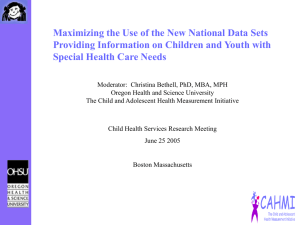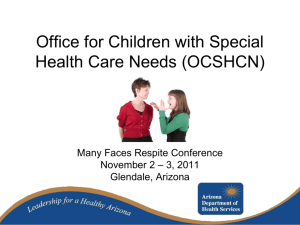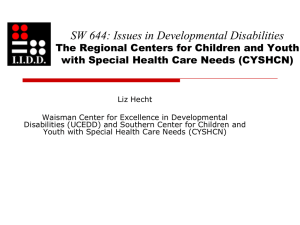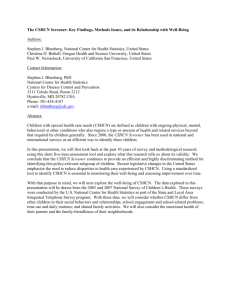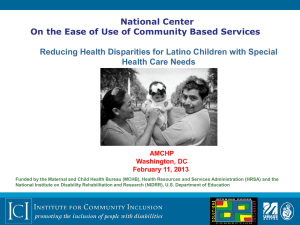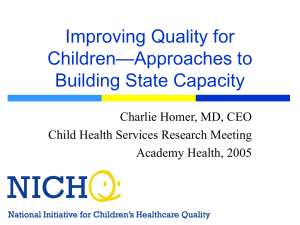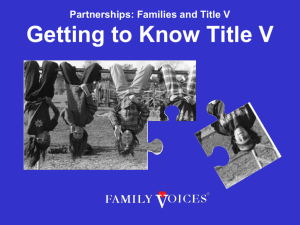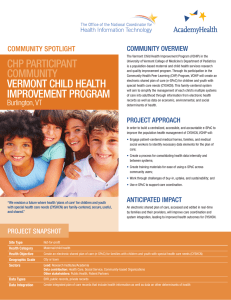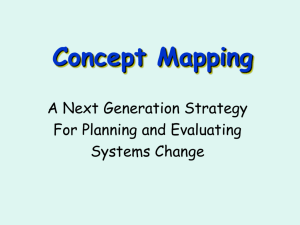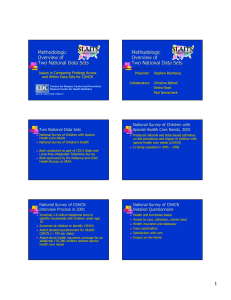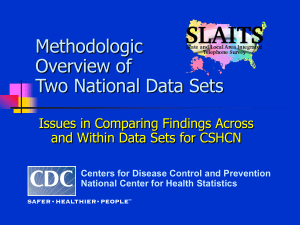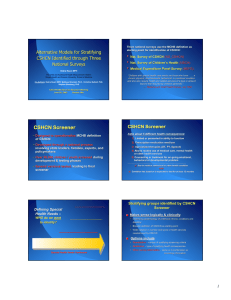Purpose • Advance understanding and widespread and
advertisement
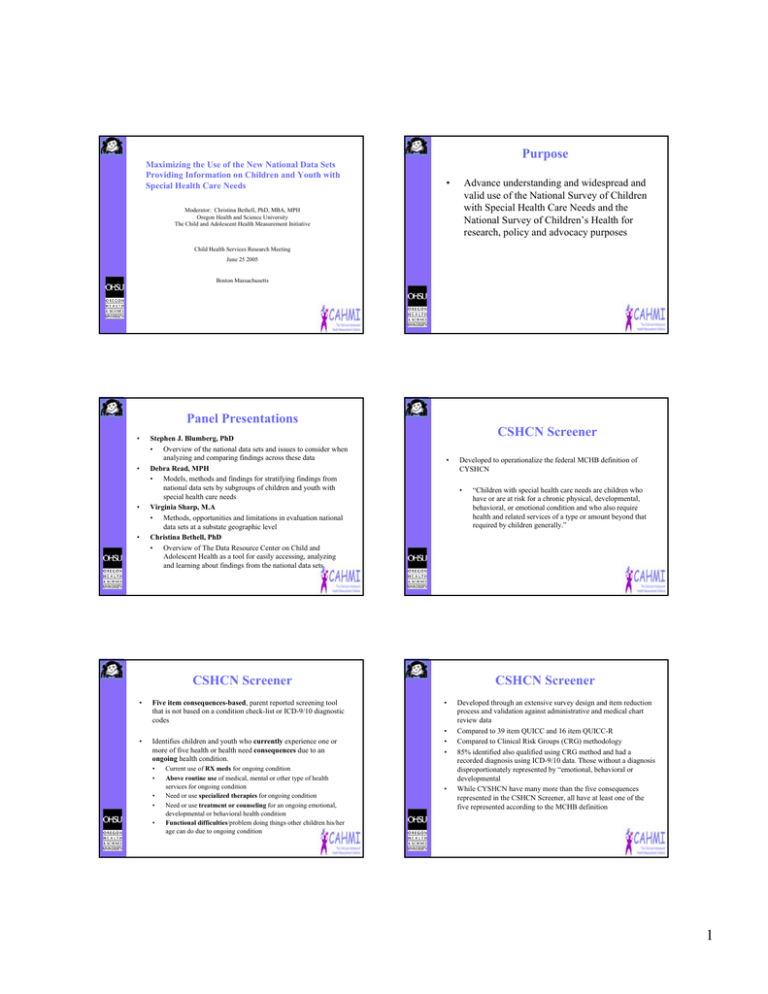
Purpose Maximizing the Use of the New National Data Sets Providing Information on Children and Youth with Special Health Care Needs • Advance understanding and widespread and valid use of the National Survey of Children with Special Health Care Needs and the National Survey of Children’s Health for research, policy and advocacy purposes Moderator: Christina Bethell, PhD, MBA, MPH Oregon Health and Science University The Child and Adolescent Health Measurement Initiative Child Health Services Research Meeting June 25 2005 Boston Massachusetts Panel Presentations • • • • Stephen J. Blumberg, PhD • Overview of the national data sets and issues to consider when analyzing and comparing findings across these data Debra Read, MPH • Models, methods and findings for stratifying findings from national data sets by subgroups of children and youth with special health care needs Virginia Sharp, M.A • Methods, opportunities and limitations in evaluation national data sets at a substate geographic level Christina Bethell, PhD • Overview of The Data Resource Center on Child and Adolescent Health as a tool for easily accessing, analyzing and learning about findings from the national data sets CSHCN Screener • • CSHCN Screener • Five item consequences-based, parent reported screening tool that is not based on a condition check-list or ICD-9/10 diagnostic codes • Identifies children and youth who currently experience one or more of five health or health need consequences due to an ongoing health condition. • • • • • Current use of RX meds for ongoing condition Above routine use of medical, mental or other type of health services for ongoing condition Need or use specialized therapies for ongoing condition Need or use treatment or counseling for an ongoing emotional, developmental or behavioral health condition Functional difficulties/problem doing things other children his/her age can do due to ongoing condition Developed to operationalize the federal MCHB definition of CYSHCN “Children with special health care needs are children who have or are at risk for a chronic physical, developmental, behavioral, or emotional condition and who also require health and related services of a type or amount beyond that required by children generally.” CSHCN Screener • • • • • Developed through an extensive survey design and item reduction process and validation against administrative and medical chart review data Compared to 39 item QUICC and 16 item QUICC-R Compared to Clinical Risk Groups (CRG) methodology 85% identified also qualified using CRG method and had a recorded diagnosis using ICD-9/10 data. Those without a diagnosis disproportionately represented by “emotional, behavioral or developmental While CYSHCN have many more than the five consequences represented in the CSHCN Screener, all have at least one of the five represented according to the MCHB definition 1 The Data Resource Center on Child and Adolescent Health (DRC) Presented by Christina Bethell, Bethell, PhD CoCo-Developers: Debra Read, Nora Wells, Brooke Latzke, Latzke, Dana Zive, Zive, NCHS, National Advisors, consultants and other staff Funding Agency: The federal Maternal and Child Health Bureau, HRSA What is the Data Resource Center? A website that delivers: – Hands-on, user-friendly access to national, state and regional data from the 2001 NSCSHCN and the 2003 National Survey of Children’s Health (NS-CH) – Technical assistance by email/telephone and online materials, such as examples of data use by states and links to related websites – Education -- thru “hot topic” e-updates & inperson, telephone, and online workshops www.childhealthdata.org D ata Resource Center for Child & Adolescent Health www.cshcndata.org www.nschdata.org Nat. Survey of Children w/ Special Health Care Needs HOMEPAGE Nat. Survey of Children’s Health HOMEPAGE Motivation for Developing the DRC •The importance of information on child and youth health and health care quality is widely acknowledged. •In recent years, with the leadership of federal agencies such as the Maternal and Child Health Bureau, previously unavailable national, state, and regional level data on child and youth health, health services need and use, and health care quality has been collected. •This information is particularly relevant to state and federal policymakers as well as health care providers and family and community leaders—many of whom lack the resources or skills to easily access this data. 2 Goals for Developing the DRC The free, web-based, publicly accessible Data Resource Center on Child and Adolescent Health was developed to Family Voices Meeting, Oct 2002 Initial reaction to and feedback on draft data center concept, educational materials & preliminary data query model by state CSHCN staff and family leaders Online Needs Assessment, Nov 2002 •further advance evidence-based policy, program development, and advocacy on behalf of children, youth and families Prototype 1.0, Jan 2003 First test version of data center Web site, educational materials. features & data query model Pilot Testing of Prototype 1.0, Feb — Mar 2003 •eliminate barriers faced by policy, provider, and advocacy audiences in obtaining information in a real time and user-friendly manner •build data literacy On going development & refinement of draft educational materials and direct data query model, Oct - Mar 2003 Online request for information from states and families (n = 70; 35 State Represented) Key Informant Interviews Dec — Feb 2003 Series of one hour semi-structured interviews with state CSHCN Title V directors and family leaders (n = 20) Public input process with families and states Family Voices National Conference workshop, Feb 2003 Technical Specifications, Dec 2002 Preliminary identification of key data resource center features and summary of technical specifications & costs for building and maintaining a Web-based data resource center. (Task 4; Deliverable #3) Expert interviews and scan of existing “model” Web sites, Oct — Nov 2002 Prototype 2.0, April 2003 Revised data center prototype & educational materials finalized Identification of prospective vendors; procurement of technical bids, Nov — Dec 2002 On line demo at Tri Regional Title V Conference , Feb 2003 (n = 60) National AMCHP Meeting presentation , Mar 2003 (Tasks 6 & 8) Focus group with WA state CSHCN program staff & family leaders, Mar 2003 (Tasks 6 & 8) NSCH Survey questions address: Data Resource Center Functions • Child health & functional status •Directly search for data from a set of standardized measures about child, youth and family health, needs, and health care quality • Health insurance • Interactively compare national, state, and regional survey results by geographic area and socio-demographic groups • Medical Home • Learn to use data more effectively to assess needs and performance as well as to check assumptions • Early childhood (ages 0-5) • Discover how other state and family leaders are using data to inform and stimulate systems development and change • Get expert help via e-mail, telephone, or through a series of in-person or online skills building workshops • Health care access & utilization • Middle childhood & adolescence (ages 6-17) • Family functioning • Parental health • Neighborhood characteristics Survey yields over 60 key indicators of child health & well-being in the following areas: • Child’s health status: physical, emotional, dental • Child’s health care – including medical home • Child’s school & activities • Child’s family – including maternal health status NS-CSHCN Data Search Topics 1) Children with & without special health needs 2) Households with & without CYSHCN 3) CYSHCN population only 4) Demographics (all children or all households) 5) CYSHCN Health & functioning (Section 3) 6) CYSHCN Access to services & unmet needs (Section 4) 7) CYSHCN Health care experiences (Section 6) 8) CYSHCN Insurance status (Section 7) 9) CYSHCN Adequacy of insurance coverage (Section 8) 10) CYSHCN Impact on family (Section 9) • Child & Family’s neighborhood 11) MCHB core outcomes for CYSHCN 12) State profile key indicators 3 Data Resource Center Applications Data Resource Center Applications . Educating policymakers Identifying/documenting needs •What are key policy issues for your state or population of interest? •How many children have what needs? •How does data support what users are hearing from the field (providers, families, other agencies)? •What programs need what information? •What data could help them learn about child health needs? Advocacy Building improvement partnerships •What partners could use this data: public programs, health plans, hospitals, providers, community groups, faith-based organizations? •Using data to inform and focus efforts to improve care. •Are there anticipated key pressure points in program budgets or priorities? •What methods would be most effective in presenting your case? •How could you use data in fact sheets, testimony, and the media, along with family stories? Grant Writing •Using data to frame the need and design STEP 1 Data Search Recipe Data Resource Center Status and Future Development Status of DRC Web Portals www.cshcndata.org launched April 2004 (Approximately 105,000 hits prior to outreach and marketing.) STEP 2 www.nschdata.org soft launch May 2005 (Over 82,000 hits – prior to hard launch or outreach and marketing.) Future Development •Starting in July 2005, the DRC will move into an outreach and marketing phase to motivate and expand use of data by non-technical and other audiences. •The DRC will be further developed on an ongoing basis and is expected to include data from additional surveys over time. STEP 3 •New features will include the capacity for sub-state geographic analyses, trending data (when future years of data are included), querying multiple indicators at one time, and new online workshops, resources, and examples for using data to stimulate systems change. Using data to stimulate system change Data Resource Center for the National Survey of Children’s Health and the NS-CSHCN Online Tour The QUEST! • Question: What is the actionable question? • Understanding: What are the relevant variables, measures and analyses to address the question? • Efficiently and effectively analyze data • Synthesize and summarize results in a relevant manner for each audience • Tell the story and take action! 4 Visit soon! • National Survey of Children with Special Health Care Needs www.cshcndata.org • National Survey of Children’s Health www.nschdata.org 5 6 7 8 9 10 11 12 13
